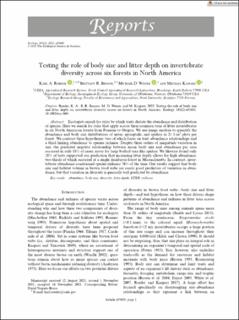| dc.contributor.author | Roeder, Karl A. | |
| dc.contributor.author | Benson, Brittany R. | |
| dc.contributor.author | Weiser, Michael D. | |
| dc.contributor.author | Kaspari, Michael | |
| dc.date.accessioned | 2022-03-09T14:45:36Z | |
| dc.date.available | 2022-03-09T14:45:36Z | |
| dc.date.created | 2022-01-06T18:48:27Z | |
| dc.date.issued | 2021 | |
| dc.identifier.citation | Roeder, K. A., Benson, B. R., Weiser, M. D. & Kaspari, M. (2021). Testing the role of body size and litter depth on invertebrate diversity across six forests in North America. Ecology, 103(2): e03601. doi: | en_US |
| dc.identifier.issn | 1939-9170 | |
| dc.identifier.uri | https://hdl.handle.net/11250/2984094 | |
| dc.description.abstract | Ecologists search for rules by which traits dictate the abundance and distribution of species. Here we search for rules that apply across three common taxa of litter invertebrates in six North American forests from Panama to Oregon. We use image analysis to quantify the abundance and body size distributions of mites, springtails, and spiders in 21 1-m2 plots per forest. We contrast three hypotheses: two of which focus on trait–abundance relationships and a third linking abundance to species richness. Despite three orders of magnitude variation in size, the predicted negative relationship between mean body size and abundance per area occurred in only 18% of cases, never for large bodied taxa like spiders. We likewise found only 18% of tests supported our prediction that increasing litter depth allows for high abundance; two-thirds of which occurred at a single deciduous forest in Massachusetts. In contrast, invertebrate abundance constrained species richness 76% of the time. Our results suggest that body size and habitat volume in brown food webs are rarely good predictors of variation in abundance, but that variation in diversity is generally well predicted by abundance. | en_US |
| dc.language.iso | eng | en_US |
| dc.publisher | Wiley | en_US |
| dc.title | Testing the role of body size and litter depth on invertebrate diversity across six forests in North America | en_US |
| dc.type | Peer reviewed | en_US |
| dc.type | Journal article | en_US |
| dc.description.version | publishedVersion | en_US |
| dc.rights.holder | © 2021 The Ecological Society of America | en_US |
| dc.subject.nsi | VDP::Matematikk og Naturvitenskap: 400::Zoologiske og botaniske fag: 480::Økologi: 488 | en_US |
| dc.source.pagenumber | 7 | en_US |
| dc.source.volume | 103 | en_US |
| dc.source.journal | Ecology | en_US |
| dc.source.issue | 2 | en_US |
| dc.identifier.doi | 10.1002/ecy.3601 | |
| dc.identifier.cristin | 1976199 | |
| dc.source.articlenumber | e03601 | en_US |
